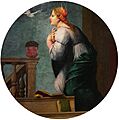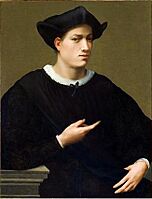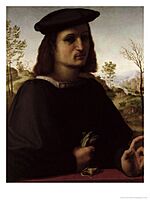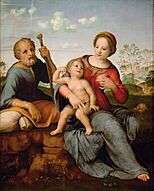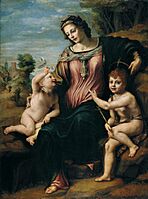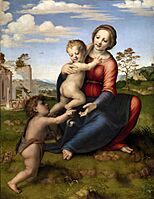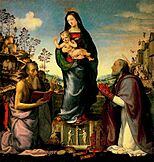Franciabigio facts for kids
Franciabigio (born 1482, died 1525) was an Italian painter from Florence, Italy. He lived during the exciting period known as the Renaissance. His real name might have been Francesco di Cristofano. People also called him Marcantonio Franciabigio or Francia Bigio.
Contents
Life and Career
Early Life and Training
Franciabigio was born in Florence, a famous city in Italy. He started his art training with another painter named Albertinelli around 1506. In 1505, he became friends with Andrea del Sarto, who was also a talented painter. By the next year, they opened an art studio together in Florence.
Franciabigio was very interested in how the human body works (called anatomy) and how to make things look far away or close up in a painting (called perspective). He also focused on making his figures the right size. He was known for being very careful and hardworking in his art.
Painting Techniques
Franciabigio was especially good at painting frescos. Fresco is a way of painting on wet plaster walls, which makes the colors last a very long time. A famous art historian named Vasari even said that Franciabigio was better than anyone else at this method during his time.
While he painted many religious scenes and frescoes, his most powerful and realistic paintings were his portraits. These showed people in a very natural way. As he got more famous and received many requests for public paintings, some people felt he didn't work as carefully as before.
Famous Artworks and Collaborations
In 1513, Franciabigio painted a fresco called Marriage of the Virgin. This was in the cloister (a covered walkway) of the Annunziata church in Florence. This painting was part of a bigger series of artworks, mostly led by his friend Andrea del Sarto. Other artists like Rosso Fiorentino and Pontormo also worked on this project.
In 1514, he painted a Last Supper fresco for a convent in Florence. Later, in 1518-19, he created more frescoes for another convent. These showed scenes from the life of John the Baptist, like his Departure for the Desert and his Meeting with Jesus.
Around 1520–21, Franciabigio worked at the Medici family's villa in Poggio a Caiano. He painted a large fresco called Triumph of Cicero in the main hall. However, his work was often compared to the amazing paintings of Pontormo, another artist who worked there.
In the early 1520s, Franciabigio also painted a Madonna and Christ Child. This painting showed how much he was influenced by the famous artist Raphael. Art experts say this painting is important because it shows how realistic his art could be.
Recognizable Style
Some paintings that were once thought to be by Raphael are now believed to be by Franciabigio. These include the Madonna del Pozzo and some of his portraits, like the Young Man. These paintings share a similar style with other works that are definitely known to be by Franciabigio, such as Youth at a Window in the Pitti Gallery.
Franciabigio and Andrea del Sarto kept their art studio together for many years. Along with Andrea's student, Jacopo da Pontormo, they decorated the Medici villa at Poggio a Caiano. Franciabigio's Triumph of Caesar there shows his skill at telling stories through painting. Andrea's influence can be seen in Franciabigio's St. Job Altar (1516), which has a dark, smoky background and soft, dramatic lighting.
His many portraits together show his unique and amazing talent. Two other famous works by him are the Calumny of Apelles in the Pitti Palace and the Bath of Bathsheba (painted in 1523) in the Dresden gallery.
Artistic Style and Legacy
When compared to his younger friend Andrea del Sarto, Franciabigio's figures often look more like sculptures and less modern. His paintings show a strong, almost stiff, way of posing figures, which was common in art from the 1400s. Franciabigio focused more on clear lines and balance in his frescoes, similar to the artist Massacio. In contrast, Sarto's paintings had a different feel, more like Venetian art, and showed the beginnings of a new style called "Mannerism" that became popular later.
Images for kids
- Franciabigio's portraits
- Franciabigio's madonnas




